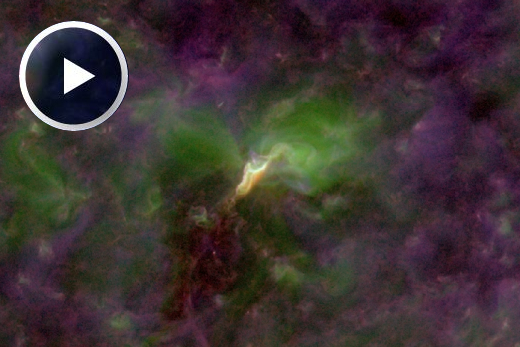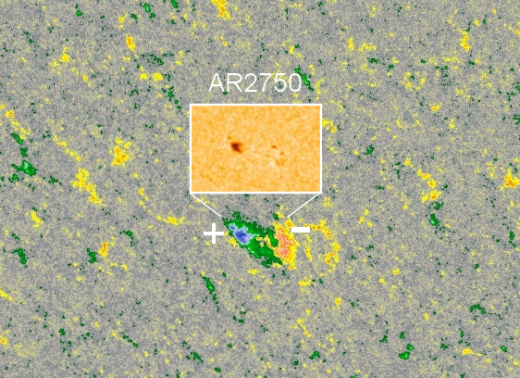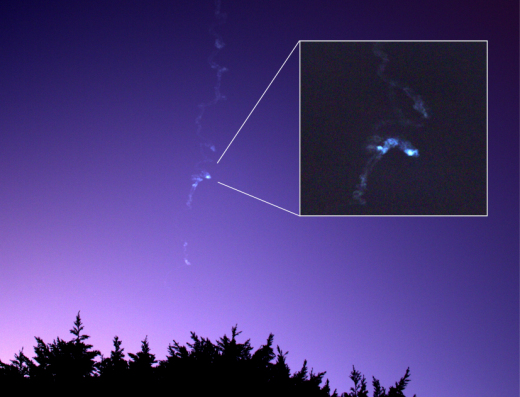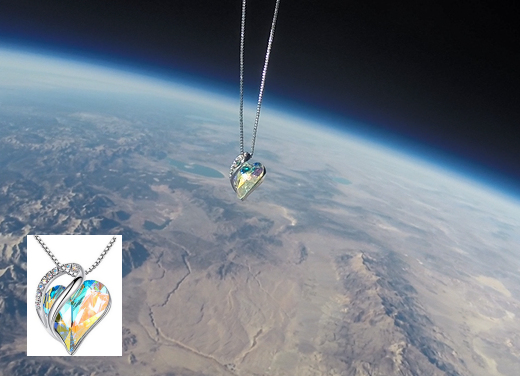Solar minimum is here - but even now strangely beautiful auroras are dancing around the poles. Deep inside the Arctic Circle, the expert guides of Aurora Holidays in Utsjoki, Finland, can help you chase them. Book now! | | |
SOLAR WIND, INCOMING: A new hole is opening in the sun's atmosphere, and it is spewing a stream of solar wind toward Earth. Estimated time of arrival: Nov. 10-11. Arctic sky watchers should be alert for extra-bright auroras on those dates. Aurora Alerts: SMS Text.
SIGNS OF LIFE FROM SOLAR CYCLE 25: Big things have small beginnings. Years from now, observers may look back from the perch of a new Solar Maximum and realize that the action began on Nov. 5, 2019, with a very small solar flare. NASA's Solar Dynamics Observatory recorded the blast:

This is a B1-class solar flare--that is, relatively small, ~1000 times weaker than the intense X-flares of Solar Maximum. It is significant not because of its intensity, but rather because of its origin. It came from AR2750, an active region belonging to the next solar cycle.
Sunspot AR2750 first appeared in the sun's southern hemisphere on Nov. 1st, breaking a string of 28 spotless days. A picture of the emerging sunspot is inset in this magnetic map of the sun's surface from the Solar Dynamics Observatory:

How do we know AR2750 belongs to the next solar cycle? Its magnetic polarity tells us so. Southern sunspots from old Solar Cycle 24 have a -/+ polarity. This sunspot is the opposite: +/-. According to Hale's Law, sunspots switch polarities from one solar cycle to the next. AR2750 is therefore a member of new Solar Cycle 25.
Solar cycles always mix at their boundaries. So far this year, short-lived sunspots likely belonging to Solar Cycle 25 have been reported on May 28, July 1st, July 8th, and Nov. 1st. They were interspersed with a similar number of old Solar Cycle 24 spots. This type of mixing is normal.
The increasing frequency of new cycle sunspots does not mean Solar Minimum is finished. On the contrary, low solar activity will probably continue for at least another year. However, it does mean that new Solar Cycle 25 is slowly sputtering to life--a process that will accelerate in the years ahead. If forecasters are correct, Solar Cycle 25 sunspots will eventually dominate the solar disk, bringing a new Solar Maximum as early as 2023.
Realtime Aurora Photo Gallery
Free: Spaceweather.com Newsletter
A TAURID EXPLODES OVER AUSTRALIA: When the sun set over Swan Hill, Australia, on Nov. 6th, at first the sky began to darken as usual. And then ... it exploded. "I witnessed an incredible twilight fireball just as I just arrived home from work at 8:08 pm AEDT (9:08 UT) 7 minutes after local sunset," reports Michael Mattiazzo. "The fireball's magnitude was at least -8, closer to -10, and multiple outbursts were observed before it completely disintegrated."

"The sonic boom arrived about 3 minutes later, sounding like the rumble of thunder," he adds. "Local dogs were even barking at the sound. The vapour trail (pictured above) lasted about 25 minutes."
Mattiazzo says the fireball streaked from east to west across the sky. The direction marks it as a likely earthgrazing Taurid fireball.
This week, Earth is passing through a stream of debris from Comet Encke, source of the annual Taurid meteor shower. Gravel-sized meteoroids hitting Earth's upper atmosphere at 65,000 mph are creating a spray of bright meteors from the constellation Taurus.
Taurids are sometimes called "the Halloween fireballs" because they are most often noticed by crowds outdoors after dark on Halloween. In fact, they may be seen on any night from mid-October to mid-November. Typical Taurid meteor rates are no more than a few per hour but, sometimes, as Mattiazzo observed, one fireball is enough.
Realtime Spaceweather Photo Gallery
Free: Spaceweather.com Newsletter
THE STRATOSPHERIC CLOUD PENDANT: The most beautiful clouds on Earth are located in the stratosphere: Polar Stratospheric Clouds. Their extraordinary colors inspired this authentic Swarovski pendant--and it has been to the stratosphere! On Nov. 2, 2019, it hitched a ride 109,580 feet high on board an Earth to Sky Calculus cosmic ray balloon:

You can have it for $159.95. The students are selling Stratospheric Cloud Pendants to support their cosmic ray ballooning program. Each heart-shaped pendant comes with a card showing it floating through the stratosphere like a real cloud, and telling the story of its journey to the edge of space and back again.
Far Out Gifts: Earth to Sky Store
All sales support hands-on STEM education
Every night, a network of
NASA all-sky cameras scans the skies above the United States for meteoritic fireballs. Automated software maintained by NASA's Meteoroid Environment Office calculates their orbits, velocity, penetration depth in Earth's atmosphere and many other characteristics. Daily results are presented here on Spaceweather.com.
On Nov. 07, 2019, the network reported 17 fireballs.
(13 sporadics, 4 northern Taurids)

In this diagram of the inner solar system, all of the fireball orbits intersect at a single point--Earth. The orbits are color-coded by velocity, from slow (red) to fast (blue). [Larger image] [movies]
Potentially Hazardous Asteroids (
PHAs) are space rocks larger than approximately 100m that can come closer to Earth than 0.05 AU. None of the known PHAs is on a collision course with our planet, although astronomers are finding
new ones all the time.
On November 7, 2019 there were 2018 potentially hazardous asteroids.
 |
Recent & Upcoming Earth-asteroid encounters: | Asteroid | Date(UT) | Miss Distance | Velocity (km/s) | Diameter (m) |
| 2019 UR12 | 2019-Nov-02 | 9.8 LD | 6.7 | 47 |
| 2019 VV | 2019-Nov-02 | 6.3 LD | 8.7 | 31 |
| 2019 VW | 2019-Nov-02 | 5.6 LD | 4 | 16 |
| 2019 VU3 | 2019-Nov-02 | 9.3 LD | 16.1 | 15 |
| 2019 VA | 2019-Nov-02 | 0.3 LD | 8.6 | 8 |
| 2019 VG3 | 2019-Nov-02 | 5.1 LD | 9.4 | 9 |
| 2019 UU3 | 2019-Nov-02 | 13.3 LD | 13.9 | 30 |
| 2015 JD1 | 2019-Nov-03 | 12.9 LD | 11.9 | 269 |
| 2019 VS3 | 2019-Nov-03 | 5 LD | 7 | 7 |
| 2019 VM2 | 2019-Nov-03 | 3.6 LD | 15.1 | 14 |
| 2019 UL8 | 2019-Nov-03 | 2.8 LD | 12.8 | 19 |
| 2019 UH3 | 2019-Nov-03 | 10.4 LD | 8.5 | 25 |
| 2019 VB3 | 2019-Nov-04 | 11.7 LD | 2.5 | 8 |
| 2019 VD | 2019-Nov-04 | 0.5 LD | 12 | 12 |
| 2019 VR | 2019-Nov-04 | 0.4 LD | 9.6 | 9 |
| 2019 VQ3 | 2019-Nov-05 | 12.3 LD | 8.7 | 13 |
| 2019 VD3 | 2019-Nov-05 | 2.6 LD | 9.4 | 24 |
| 2019 VO3 | 2019-Nov-05 | 13.8 LD | 14.9 | 24 |
| 2019 UH5 | 2019-Nov-05 | 13.3 LD | 3.5 | 12 |
| 2019 VU | 2019-Nov-05 | 2.7 LD | 15.3 | 12 |
| 2019 UE13 | 2019-Nov-06 | 8.3 LD | 8.9 | 26 |
| 2019 UM13 | 2019-Nov-06 | 11.5 LD | 5.9 | 17 |
| 2019 VR1 | 2019-Nov-06 | 2.9 LD | 9.3 | 14 |
| 2019 VE3 | 2019-Nov-07 | 19.7 LD | 31.3 | 77 |
| 2019 VA4 | 2019-Nov-07 | 11.2 LD | 6.2 | 10 |
| 2019 UL4 | 2019-Nov-07 | 16.7 LD | 9 | 30 |
| 2019 UO7 | 2019-Nov-07 | 3.8 LD | 4.1 | 10 |
| 2019 VM1 | 2019-Nov-08 | 11.3 LD | 6.1 | 19 |
| 2019 UM12 | 2019-Nov-08 | 1.3 LD | 13.6 | 40 |
| 2019 UR4 | 2019-Nov-08 | 7.3 LD | 4.5 | 15 |
| 2019 VE2 | 2019-Nov-09 | 7.1 LD | 5 | 12 |
| 2019 VP3 | 2019-Nov-09 | 6.5 LD | 9.4 | 9 |
| 2019 VT3 | 2019-Nov-10 | 9.5 LD | 5.3 | 8 |
| 2019 UB7 | 2019-Nov-10 | 13.7 LD | 17.5 | 56 |
| 2019 VX3 | 2019-Nov-11 | 4 LD | 16 | 15 |
| 2019 VX2 | 2019-Nov-11 | 3.6 LD | 6.2 | 6 |
| 2019 VN | 2019-Nov-11 | 3.1 LD | 13.6 | 32 |
| 2019 VW1 | 2019-Nov-12 | 15.3 LD | 8.5 | 26 |
| 2019 VK3 | 2019-Nov-12 | 10.6 LD | 19.5 | 26 |
| 2019 VN2 | 2019-Nov-12 | 16 LD | 3.8 | 14 |
| 2010 JG | 2019-Nov-12 | 19.6 LD | 14.9 | 235 |
| 2019 UB14 | 2019-Nov-12 | 4.9 LD | 15.4 | 22 |
| 2019 UH1 | 2019-Nov-13 | 9.5 LD | 9.1 | 51 |
| 2019 UN12 | 2019-Nov-13 | 3.8 LD | 28.8 | 146 |
| 2019 VX | 2019-Nov-13 | 4.1 LD | 10.8 | 31 |
| 2019 UE8 | 2019-Nov-15 | 7.7 LD | 6.6 | 26 |
| 2019 UR2 | 2019-Nov-18 | 18 LD | 13.4 | 128 |
| 2019 UK6 | 2019-Nov-20 | 15.4 LD | 7.7 | 63 |
| 481394 | 2019-Nov-21 | 11.3 LD | 7.9 | 372 |
| 2019 VK | 2019-Nov-21 | 5.8 LD | 7.6 | 42 |
| 2008 EA9 | 2019-Nov-23 | 10.5 LD | 2.2 | 10 |
| 2019 VF1 | 2019-Nov-25 | 13.4 LD | 17.3 | 89 |
| 2017 AP4 | 2019-Dec-03 | 8.5 LD | 7.5 | 15 |
| 2018 XW2 | 2019-Dec-07 | 17.4 LD | 13 | 28 |
| 216258 | 2019-Dec-20 | 15.3 LD | 11.8 | 324 |
| 2013 XY20 | 2019-Dec-21 | 18.4 LD | 1.9 | 28 |
| 2017 XQ60 | 2019-Dec-22 | 11 LD | 15.6 | 47 |
| 310442 | 2019-Dec-26 | 19 LD | 12.3 | 372 |
| 2019 AE3 | 2020-Jan-02 | 4.9 LD | 8.2 | 13 |
Notes: LD means "Lunar Distance." 1 LD = 384,401 km, the distance between Earth and the Moon. 1 LD also equals 0.00256 AU. MAG is the visual magnitude of the asteroid on the date of closest approach. | | Cosmic Rays in the Atmosphere |
SOMETHING NEW! We have developed a new predictive model of aviation radiation. It's called E-RAD--short for Empirical RADiation model. We are constantly flying radiation sensors onboard airplanes over the US and and around the world, so far collecting more than 22,000 gps-tagged radiation measurements. Using this unique dataset, we can predict the dosage on any flight over the USA with an error no worse than 15%.
E-RAD lets us do something new: Every day we monitor approximately 1400 flights criss-crossing the 10 busiest routes in the continental USA. Typically, this includes more than 80,000 passengers per day. E-RAD calculates the radiation exposure for every single flight.
The Hot Flights Table is a daily summary of these calculations. It shows the 5 charter flights with the highest dose rates; the 5 commercial flights with the highest dose rates; 5 commercial flights with near-average dose rates; and the 5 commercial flights with the lowest dose rates. Passengers typically experience dose rates that are 20 to 70 times higher than natural radiation at sea level.
To measure radiation on airplanes, we use the same sensors we fly to the stratosphere onboard Earth to Sky Calculus cosmic ray balloons: neutron bubble chambers and X-ray/gamma-ray Geiger tubes sensitive to energies between 10 keV and 20 MeV. These energies span the range of medical X-ray machines and airport security scanners.
Column definitions: (1) The flight number; (2) The maximum dose rate during the flight, expressed in units of natural radiation at sea level; (3) The maximum altitude of the plane in feet above sea level; (4) Departure city; (5) Arrival city; (6) Duration of the flight.
SPACE WEATHER BALLOON DATA: Approximately once a week, Spaceweather.com and the students of Earth to Sky Calculus fly space weather balloons to the stratosphere over California. These balloons are equipped with radiation sensors that detect cosmic rays, a surprisingly "down to Earth" form of space weather. Cosmic rays can seed clouds, trigger lightning, and penetrate commercial airplanes. Furthermore, there are studies ( #1, #2, #3, #4) linking cosmic rays with cardiac arrhythmias and sudden cardiac death in the general population. Our latest measurements show that cosmic rays are intensifying, with an increase of more than 18% since 2015:

The data points in the graph above correspond to the peak of the Reneger-Pfotzer maximum, which lies about 67,000 feet above central California. When cosmic rays crash into Earth's atmosphere, they produce a spray of secondary particles that is most intense at the entrance to the stratosphere. Physicists Eric Reneger and Georg Pfotzer discovered the maximum using balloons in the 1930s and it is what we are measuring today.
En route to the stratosphere, our sensors also pass through aviation altitudes:

In this plot, dose rates are expessed as multiples of sea level. For instance, we see that boarding a plane that flies at 25,000 feet exposes passengers to dose rates ~10x higher than sea level. At 40,000 feet, the multiplier is closer to 50x.
The radiation sensors onboard our helium balloons detect X-rays and gamma-rays in the energy range 10 keV to 20 MeV. These energies span the range of medical X-ray machines and airport security scanners.
Why are cosmic rays intensifying? The main reason is the sun. Solar storm clouds such as coronal mass ejections (CMEs) sweep aside cosmic rays when they pass by Earth. During Solar Maximum, CMEs are abundant and cosmic rays are held at bay. Now, however, the solar cycle is swinging toward Solar Minimum, allowing cosmic rays to return. Another reason could be the weakening of Earth's magnetic field, which helps protect us from deep-space radiation.
| | The official U.S. government space weather bureau |
| | The first place to look for information about sundogs, pillars, rainbows and related phenomena. |
| | Researchers call it a "Hubble for the sun." SDO is the most advanced solar observatory ever. |
| | 3D views of the sun from NASA's Solar and Terrestrial Relations Observatory |
| | Realtime and archival images of the Sun from SOHO. |
| | from the NOAA Space Environment Center |
| | fun to read, but should be taken with a grain of salt! Forecasts looking ahead more than a few days are often wrong. |
| | from the NOAA Space Environment Center |
| | the underlying science of space weather |
 | To find reviews of new online casino sites in the UK try The Casino DB where there are hundreds of online casino reviews complete with bonuses and ratings. Get a bonus when playing at a new casino in the UK. The Genie got you covered! Looking for a new online casino? Try Casimpo the new site dedicated to making online casino simple and easy for all. |
| | These links help Spaceweather.com stay online. Thank you to our supporters! |
| | | | | | |

